At last a new bird for my list,a Ring Billed Gull,it is an American gull an increasingly frequent visitor from North America. Reports suggest that about 20-40 birds winter in UK. Occurs most regularly at coastal sites such as estuaries but also inland at gull roosts. It has been eight weeks and a day since I last saw a new bird for my list.
 Reaching 160 has made me really happy as it was my target for the year.Half way through the year I began to wonder whether I would ever make it! So now my aim is 165 by the end of the year.
Reaching 160 has made me really happy as it was my target for the year.Half way through the year I began to wonder whether I would ever make it! So now my aim is 165 by the end of the year.I went down to the Whitehouse Lagoon
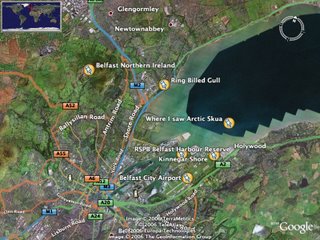 on the outskirts of Belfast a well known haunt for gulls and waders this morning. I had been down yesterday and saw the Ring Billed Gull for the briefest of moments and by the time I got my camera from the car I could not find it again.So I was glad to find it again today and get a record shot. There was another birder down there Mike Meidlinger who thought he might have a Caspian Gull as well. Im not that good at gulls so wouldnt have known whether there was one or not. I did then go over to the RSPB hide on the other side of the lough where a juvenile Glaucous gull was found by Joe Lamont.
on the outskirts of Belfast a well known haunt for gulls and waders this morning. I had been down yesterday and saw the Ring Billed Gull for the briefest of moments and by the time I got my camera from the car I could not find it again.So I was glad to find it again today and get a record shot. There was another birder down there Mike Meidlinger who thought he might have a Caspian Gull as well. Im not that good at gulls so wouldnt have known whether there was one or not. I did then go over to the RSPB hide on the other side of the lough where a juvenile Glaucous gull was found by Joe Lamont.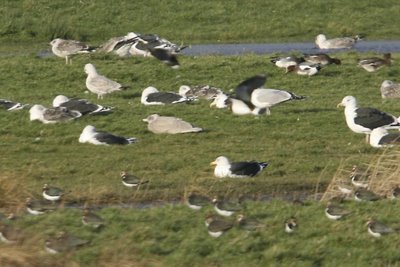
Talking of things American we have a few visiting ducks from America at the moment. The Barrow's Goldeneye (Bucephala islandica) at the River Quoile a few miles from where I live is a medium-sized sea duck of the genus Bucephala, the goldeneyes.
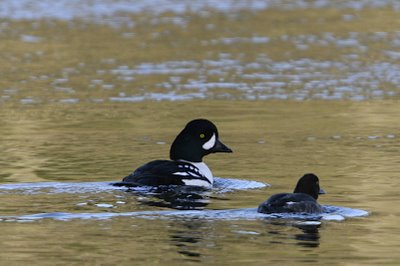
Adults are similar in appearance to the Common Goldeneye. Adult males have a dark head with a purplish gloss and a white crescent at the front of the face. Adult females have a yellow bill.
Their breeding habitat is wooded lakes and ponds primarily in northwestern North America but also in scattered locations in eastern Canada and Iceland. They nest in cavities in trees, also in burrows or protected sites on the ground.
They are migratory and most winter in protected coastal waters or open inland waters. These diving birds forage underwater. They eat aquatic insects, crustaceans and pond vegetation. It is an extremely rare vagrant to western Europe.
We also have the Green Winged Tealat the Belfast Harbour Reserve. The Green-winged Teal (GWT, Anas carolinensis) is a common and widespread duck which breeds in the northern areas of North America except on the Aleutian Islands. It was considered conspecific with the Common Teal for some time, and the issue is still being reviewed by the AOU [1]; based on this the IUCN and BirdLife International (BirdLife International, 2004) do not accept it as a separate species at present. However, nearly all other authorities consider it distinct nowadays, based on behavioral (Laurie-Ahlberg & McKinney 1979), morphological (Livezey, 1991), and molecular (Johnson & Sorenson 1999) evidence (discussed by Sangster et al., 2002). You can see the difference in the photo below.
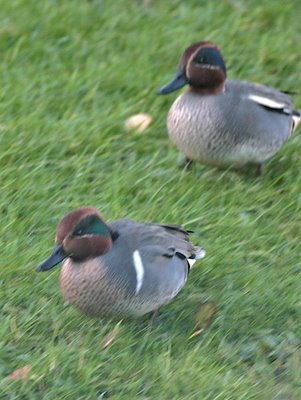
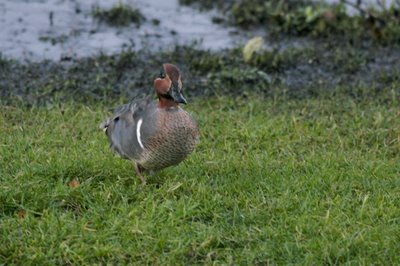
This dabbling duck is strongly migratory and winters far south of its breeding range. It is highly gregarious outside of the breeding season and will form large flocks. In flight, the fast, twisting flocks resemble waders.
This is the smallest North American dabbling duck. The breeding male has grey flanks and back, with a yellow rear end and a white-edged green speculum, obvious in flight or at rest. It has a chestnut head with a green eye patch. It is distinguished from drake Common Teal (the Eurasian relative of this bird) by a vertical white stripe on side of breast, the lack of both a horizontal white scapular stripe and the lack of thin buff lines on its head.
The females are light brown, with plumage much like a female Mallard. They can be distinguished from most ducks on size and shape, and the speculum. Separation from female Common Teal is problematic.
In non-breeding (eclipse) plumage, the drake looks more like the female.
It is a common duck of sheltered wetlands, such as taiga bogs, and usually feeds by dabbling for plant food or grazing. It nests on the ground, near water and under cover. While its conservation status is not evaluated by IUCN at present due to non-recognition of the taxon, it is plentiful enough to make it a species of Least Concern if it were; it is far more plentiful than the Common Teal (Carboneras, 1992). It can be seen in vast numbers in the Marismas Nacionales of western Mexico, a main wintering area.
This is a noisy species. The male has a clear whistle, whereas the female has a feeble "quack".
There is also a female Lesser Scaup (Photo courtesy Derek Charles)
 at the Clea Lakes Killyleagh which as the crow flies is probably only about three miles away from me or thirteen by car :-( The Lesser Scaup (Aythya affinis) is a small diving duck.
at the Clea Lakes Killyleagh which as the crow flies is probably only about three miles away from me or thirteen by car :-( The Lesser Scaup (Aythya affinis) is a small diving duck.Adults are 38-45 cm long, with a blue bill and yellow eyes. Adult males have a dark head with a purple sheen, a black breast, a light grey back, a black tail and white underparts. Adult females have a white band at the base of the bill and a brown head and body. They are smaller than the Greater Scaup.
Their breeding habitat is marsh ponds in Alaska and western Canada. They nest in a sheltered location on the ground near water.
There can be difficulties for inexperienced birdwatchers in distinguishing the Greater and Lesser Scaup. The differently colored sheen on the head is unreliable because light conditions vary, and these birds are often far from the shoreline.
The Lesser Scaup is best identified on its much smaller size, different head shape with a peaked hind crown, and a white wing bar that is visible only on the secondaries (it extends onto the primaries in Greater). The drake also shows vermiculations on the back. In North America, a large scaup flock will often have both species present.
Lesser Scaup migrate in flocks and winter in lakes, rivers and sheltered coastal waters along the west coast of North America, the southern United States and northern South America. They are more likely to be found on freshwater than Greater Scaup. These birds move south late in the fall and return in early spring.They are a rare but apparently increasing vagrant to western Europe, where the identification also needs to exclude similar looking hybrids.
I now have to try and find it to get me on my way to 165!!
No comments:
Post a Comment